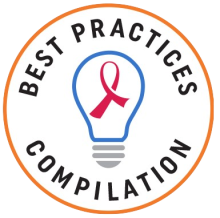The RWHAP Best Practices Compilation gathers and disseminates interventions that improve outcomes along the HIV care continuum. Explore the Compilation to find inspiration and new ideas for improving the care of people with HIV. Learn more about the Best Practices Compilation and submit your innovation today for possible inclusion.
Search Results
Displaying 1 - 10 of 122
Southern Nevada Rapid stART improves access to immediate prescription of ART in the region. Led by the Office of HIV within Clark County Social Service, Rapid stART was initially developed and implemented at 28 sites to link clients to a prescribing HIV provider within seven days of their HIV diagnosis, and included a Rapid stART Response Team to support clients through the process. The Rapid stART program has increased linkage to HIV medical care, initiation of ART within seven days, and viral suppression.

Emerging intervention
People with a new diagnosis of HIV
Linkage to HIV medical care; Prescription of antiretroviral therapy; Viral suppression
Clinical service delivery model; Data utilization approach; Quality improvement
NV
Multicomponent Support Strategies was implemented during the COVID-19 pandemic shelter-in-place order. Ward 86 Clinic staff and trained volunteers provided outreach to 1,816 clients about the availability of various supports, including in-person medical care, mental health and substance use services, medication delivery, food assistance, housing support services, and Positive Health Onsite Program for Unstably Housed People (POP-UP), a low-barrier high-intensity drop-in program. Results showed that viral suppression increased at a faster rate after Multicomponent Support Strategies was implemented.

Evidence-informed intervention
All clients; People who are unstably housed; People experiencing food insecurity
Viral suppression
Outreach and reengagement activities; Support service delivery model
San Francisco, CA
INFINI-T is a program designed to reach young transgender women of color with HIV and retain them in care through peer advocates who provided case management. These peer advocates facilitated social support sessions with the goal of alleviating the negative impacts of psychosocial factors like history of trauma, stigma, and discrimination. Clients were more likely to be virally suppressed and retained in care after 12 months of participating in the intervention.

Evidence-informed intervention
Transgender women; Women of color; Youth ages 13 to 24
Retention in HIV medical care; Viral suppression
Outreach and reengagement activities
Brooklyn, NY
The Brandy Martell Project aimed to engage adult transgender women of color in HIV care and increase retention in care by offering patient navigation services, workshop programming, and legal support. Evaluation results showed The Brandy Martell Project had a significantly positive effect on ART prescription for clients.

Evidence-informed intervention
Transgender women; Women of color
Prescription of antiretroviral therapy
Outreach and reengagement activities
San Francisco Bay Area, CA
In 2021, the City of New Orleans employed five CHWs to work with RWHAP Part A-funded agencies on reengaging eligible clients back into care. From February 2021 through April 2022, CHWs attempted to contact 1,215 clients disconnected from care; 207 of these attended a primary care appointment and re-entered care, a 17% success rate at reengaging clients back into care.

Evidence-informed intervention
People with HIV who are not in care
Linkage to HIV medical care
Outreach and reengagement activities
New Orleans , LA
Rise was implemented to address ART adherence issues among Black people with HIV. Through Rise, peer counselors used motivational interviewing techniques, leveraged Medication Event Monitoring System data to monitor and promote adherence, and connected participants to support services to address unmet needs. A randomized controlled trial showed that Rise participants were more likely to be adherent to ART than non-participants.

Evidence-based intervention
Black/African American people
Prescription of antiretroviral therapy
Support service delivery model
Los Angeles County, CA
This nine-month program tailored services for people with HIV by bundling three to five evidence-informed care strategies for each client, such as mental health referrals, transportation assistance, appointment reminders, and pill boxes. A primary care physician, case manager, and pharmacist coordinated with each client to address their specific needs. After the intervention, 70.1% of previously non-suppressed clients were virally suppressed.

Evidence-informed intervention
People with HIV
Viral suppression
Support service delivery model
Kansas City, KS
The Rapid ART Start Protocol focuses on helping veterans with a new HIV diagnosis access ART and comprehensive treatment as soon as possible. A retrospective cohort study showed positive outcomes, including decreases in the time to first appointment, the time to ART initiation, and the time to reach viral suppression. In addition, patients receiving the intervention were more likely to reach viral suppression compared to patients seen pre-intervention at the same clinic.

Evidence-informed intervention
People with a new diagnosis of HIV
Linkage to HIV medical care; Prescription of antiretroviral therapy; Viral suppression
Clinical service delivery model
Atlanta, GA
Taking Care of Me is a video- and poster-based intervention to promote prompt ART initiation and medication adherence for people with HIV. The video and posters are designed for use in HIV clinics, drawing on the example of similar initiatives launched in public health clinic waiting rooms that aim to reduce incidence of sexually transmitted infections. A trial testing the efficacy of Taking Care of Me found that clients exposed to the video were more likely to be prescribed ART and reach viral suppression.

Evidence-informed intervention
All clients
Prescription of antiretroviral therapy; Viral suppression
Outreach and reengagement activities
Huntsville, AL
Atlanta, GA
Golden Compass aims to serve the unique needs of older adults with HIV using a comprehensive care model designed to address comorbidities that arise with older age. Golden Compass helps address the large, yet preventable, gaps in knowledge about geriatric HIV care, resulting in high rates of patient and provider satisfaction and substantial provider reach.

Emerging intervention
People over 50 years of age
Beyond the care continuum
Clinical service delivery model
San Francisco, CA






